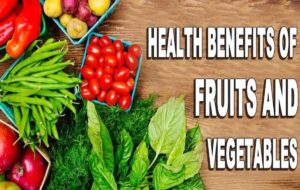
Health Benefits of Fruits and Vegetables
You get the health benefits of fruits and vegetables since fruits and vegetables are nature’s marvelous gift to humankind; indeed, they are life-enhancing medicines packed with vitamins, minerals, antioxidants, and many phytonutrients (Plant-derived micronutrients).
They are an absolute feast to our sight, not just because of their color and flavor but of their unique nutrient profile that helps the human body be fit, rejuvenate, and free of diseases!
since eating more fruit is an excellent way to improve overall health and reduce the risk of disease.
A diet rich in vegetables and fruits can lower blood pressure, reduce the risk of heart disease and stroke, prevent some types of cancer, lower the risk of eye and digestive problems, and have a positive effect on blood sugar, which can help keep the appetite in check.
Eating non-starchy vegetables and fruits like apples, pears, and green leafy vegetables may even promote weight loss. Their low glycaemic loads prevent blood sugar spikes that can increase hunger.
Fruits are an excellent source of essential vitamins and minerals, and they are high in fiber. Fruits also provide a wide range of health-boosting antioxidants, including flavonoids.
Eating a diet high in fruits and vegetables can reduce a person’s risk of developing heart disease, cancer, inflammation, and diabetes. Citrus fruits and berries may be especially powerful for preventing disease.
At least nine different families of fruits and vegetables exist, each with potentially hundreds of different plant compounds that are beneficial to health. Eat a variety of types and colors of produce in order to give your body the mix of nutrients it needs. This not only ensures a greater diversity of beneficial plant chemicals but also creates eye-appealing meals.
Healthcare professionals know that fruit is a highly nutritious, delicious, and convenient addition to any diet. With more than 2,000 varieties of fruit available, you may wonder which ones you should pick.
Each type of fruit brings its own unique set of nutrients and benefits to the table. The key is to eat fruits of various colors, as each color provides a different set of healthy nutrients.
“An apple a day keeps the doctor away,” or so the saying goes.
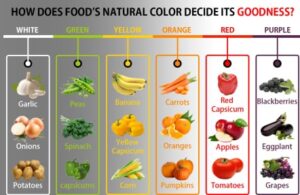
Tips for health benefits of fruits and vegetables
- Keep fruit where you can see it.Place several ready-to-eat washed whole fruits in a bowl or store chopped colorful fruits in a glass bowl in the refrigerator to tempt a sweet tooth.
- Explore the produce aisle and choose something new.Variety and color are key to a healthy diet. On most days, try to get at least one serving from each of the following categories: dark green leafy vegetables; yellow or orange fruits and vegetables; red fruits and vegetables; legumes (beans) and peas; and citrus fruits.
- Skip the potatoes.Choose other vegetables that are packed with different nutrients and more slowly digested carbohydrates.
- Make it a meal.Try cooking new recipes that include more vegetables. Salads, soups, and stir-fries are just a few ideas for increasing the number of tasty vegetables in your meals.
Researchers have studied various fruits and vegetables and ranked “powerhouse” fruit and vegetables by high nutrient density and low calories. Lemons came out top of the list, followed by strawberry, orange, lime, and pink and red grapefruit.
Green leafy vegetables, other vegetables, and fresh fruits are a treasure trove of several minerals and vitamins and hence, protect from diseases
- Normal diet, to be wholesome and tasty, should include fresh vegetables and fruits, which are storehouses of micronutrients
- Vegetables/fruits are rich sources of micronutrients.
- Fruits and vegetables also provide phytonutrients and fiber which are of vital health significance
- They help in the prevention of micronutrient malnutrition and certain chronic diseases such as cardiovascular diseases, cataracts, and cancer.
- Fresh fruits are nutritionally superior to fruit juices.
- Eat as many other vegetables as possible daily.
- Eat vegetables/ fruits in all your meals in various forms (curry, soups, mixed with curd, added to pulse preparations, and rice).
- Consume raw and fresh vegetables as salads.
- Grow the family’s requirements of vegetables in the kitchen garden if possible.
- Green leafy vegetables, when properly cleaned and cooked are safe even for infants.
- Let different varieties of vegetables and fruits add color to your plate and vitality to your life.
- Beta-carotene-rich foods like dark green, yellow, and orange-colored vegetables and fruits (GLVs, carrots, papaya, and mangoes) protect from vitamin A deficiency.
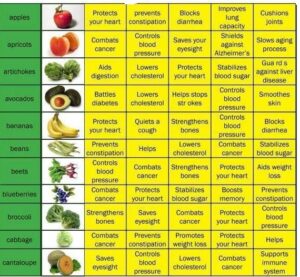
![]()
Fruits, Vegetables, and disease-
Cardiovascular disease
There is compelling evidence that a diet rich in fruits and vegetables can lower the risk of heart disease and stroke.
- A meta-analysis of cohort studies found that a higher intake of fruits and vegetables is associated with a reduced risk of death from cardiovascular disease, with an average reduction in risk of 4% for each additional serving per day of fruit and vegetables.
- The higher the average daily intake of fruits and vegetables, the lower the chances of developing cardiovascular disease. Compared with those in the lowest category of fruit and vegetable intake (less than 1.5 servings a day), those who averaged 8 or more servings a day were 30% less likely to have had a heart attack or stroke.
- Although all fruits and vegetables likely contributed to this benefit, green leafy vegetables, such as lettuce, spinach, Swiss chard, and mustard greens, were most strongly associated with decreased risk of cardiovascular disease. Cruciferous vegetables such as broccoli, cauliflower, cabbage, Brussels sprouts, bok choy, and kale; and citrus fruits such as oranges, lemons, limes, and grapefruit (and their juices) also made important contributions.
Blood pressure
- The Dietary Approaches to Stop Hypertension (DASH) study examined the effect on blood pressure of a diet that was rich in fruits, vegetables, and low-fat dairy products and that restricted the amount of saturated and total fat. The researchers found that people with high blood pressure who followed this diet reduced their systolic blood pressure (the upper number of a blood pressure reading) by about 11 mm Hg and their diastolic blood pressure (the lower number) by almost 6 mm Hg—as much as medications can achieve.
- A randomized trial showed that this fruit and vegetable-rich diet lowered blood pressure, even more, when some of the carbohydrates were replaced with healthy unsaturated fat or protein.
Cancer
A more likely possibility is that some types of fruits and vegetables may protect against certain cancers.
- A study found that those who ate the most fruit during adolescence (about 3 servings a day) compared with those who ate the lowest intakes (0.5 servings a day) had a 25% lower risk of developing breast cancer. There was a significant reduction in breast cancer in women who had eaten higher intakes of apples, bananas, grapes, and corn during adolescence, and oranges and kale during early adulthood. No protection was found from drinking fruit juices at younger ages.
- Another study was done over 20 years and found that higher fiber intakes during adolescence and early adulthood were associated with a reduced risk of breast cancer later in life. When comparing the highest and lowest fiber intakes from fruits and vegetables, women with the highest fruit fiber intake had a 12% reduced risk of breast cancer; those with the highest vegetable fiber intake had an 11% reduced risk.
- After following a large number of women it was found that women who ate more than 5.5 servings of fruits and vegetables each day (especially cruciferous and yellow/orange vegetables) had an 11% lower risk of breast cancer than those who ate 2.5 or fewer servings. Vegetable intake was strongly associated with a 15% lower risk of estrogen-receptor-negative tumors for every two additional servings of vegetables eaten daily. A higher intake of fruits and vegetables was associated with a lower risk of other aggressive tumors including HER2-enriched and basal-like tumors.
- A report by the World Cancer Research Fund suggests that non-starchy vegetables—such as lettuce and other leafy greens, broccoli, bok choy, cabbage, as well as garlic, onions, and the like—and fruits “probably” protect against several types of cancers, including those of the mouth, throat, voice box, esophagus, and stomach. Fruit probably also protects against lung cancer.
Specific components of fruits and vegetables may also be protective against cancer. For example:
- A line of research stemming from a finding from the Health Professionals Follow-up Study suggests that tomatoes may help protect men against prostate cancer, especially aggressive forms of it. One of the pigments that give tomatoes their red hue—lycopene—could be involved in this protective effect. Although several studies other than the Health Professionals Study have also demonstrated a link between tomatoes or lycopene and prostate cancer, others have not or have found only a weak connection.
- Taken as a whole, however, these studies suggest that increased consumption of tomato-based products (especially cooked tomato products) and other lycopene-containing foods may reduce the occurrence of prostate cancer. Lycopene is one of several carotenoids (compounds that the body can turn into vitamin A) found in brightly colored fruits and vegetables, and research suggests that foods containing carotenoids may protect against lung, mouth, and throat cancer. But more research is needed to understand the exact relationship between fruits and vegetables, carotenoids, and cancer.
Diabetes
Some research looks specifically at whether individual fruits are associated with the risk of type 2 diabetes. While there isn’t an abundance of research into this area yet, preliminary results are compelling.
- A study of women and men from the Health Professionals Follow-up Study—who were free of major chronic diseases—found that greater consumption of whole fruits—especially blueberries, grapes, and apples—was associated with a lower risk of type 2 diabetes. Another important finding was that greater consumption of fruit juice was associated with a higher risk of type 2 diabetes.
- Additionally a study of over 70,000 female nurses aged 38-63 years, who were free of cardiovascular disease, cancer, and diabetes, showed that consumption of green leafy vegetables and fruit was associated with a lower risk of diabetes.
- A study of over 2,300 Finnish men showed that vegetables and fruits, especially berries, may reduce the risk of type 2 diabetes.
Weight
Data from the Nurses’ Health Studies and the Health Professional’s Follow-up Study show that women and men who increased their intake of fruits and vegetables over a 24-year period were more likely to have lost weight than those who ate the same amount or those who decreased their intake. Berries, apples, pears, soy, and cauliflower were associated with weight loss while starchier vegetables like potatoes, corn, and peas were linked with weight gain. However, keep in mind that adding more produce to the diet won’t necessarily help with weight loss unless it replaces another food, such as refined carbohydrates of white bread and crackers.
Gastrointestinal health
Fruits and vegetables contain indigestible fiber, which absorbs water and expands as it passes through the digestive system. This can calm symptoms of irritable bowel and, by triggering regular bowel movements, can relieve or prevent constipation. The bulking and softening action of insoluble fiber also decreases pressure inside the intestinal tract and may help prevent diverticulosis.
Vision
Eating fruits and vegetables can also keep your eyes healthy, and may help prevent two common aging-related eye diseases—cataracts and macular degeneration—which afflict millions of Americans over age 65. Lutein and zeaxanthin, in particular, seem to reduce the risk of cataracts.
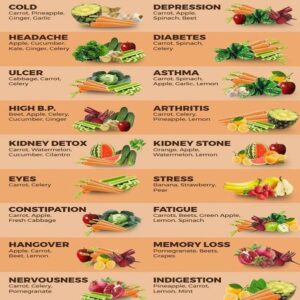
![]()
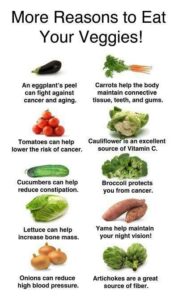
![]()